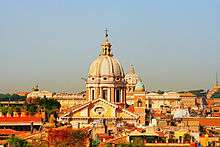San Carlo al Corso

Sant'Ambrogio e Carlo al Corso (usually known simply as San Carlo al Corso) is a basilica church in Rome, Italy, facing onto the central part of the Via del Corso. The apse of the church faces across the street, the Mausoleum of Augustus on Via di Ripetta.
This church is dedicated to Saint Ambrose and Saint Charles Borromeo, both natives of Milan. It is one of at least three churches in Rome dedicated to Borromeo, others including San Carlo ai Catinari and San Carlo alle Quattro Fontane.
Construction
Its construction was begun in honour of the canonization of St. Charles Borromeo in 1610, under the direction of Onorio Longhi and, after his death, of his son Martino Longhi the Younger. The site was that of the former church of San Nicola de Tofo. The ground plan is based on the Latin cross. The dome, resembling that of Santi Luca e Martina, was designed by Pietro da Cortona (1668), who was also responsible for the apse and rich internal decorations. The façade was designed by Cardinal Luigi Alessandro Omodei, who did not like the project prepared by Carlo Rainaldi.
Decoration
The central vault is frescoed with a Fall of the Rebel Angels (1677–1679) by Giacinto Brandi. The altarpiece, depicting the Saints Ambrose and Charles Borromeo with the Virgin and Jesus, was painted around 1685–1690 by Carlo Maratta. The stucco decoration was by Giacomo and Cosimo Fancelli. The statue of the saints were by Francesco Cavallini. Frescoes of Justice and Peace were painted by Girolamo Troppa.
In the ambulatory behind the sanctuary is a niche where a reliquary containing the heart of St Charles is kept. It was donated to the church in 1614 by Cardinal Federico Borromeo, a cousin of the saint.
The 16th-century oratory of St. Ambrose is beyond the left transept.
The first chapel on the right is dedicated to the Crucifixion and has a fresco of Vigilance by Paolo Albertoni.
The second chapel, on the right is dedicated to Mary, Aid of Christians (Maria Auxilium Christianorum), has an image of the Virgin donated by St Vincent Pallotti in the 19th century.
The third chapel on the right is dedicated to the Holy Family. On its left side is a depiction of The Redemptor and Sts Ambrose and Charles as well as the sepulchral monument of Federico Borromeo.
On the exterior, to the sides of the apse and facing the ancient Mausoleum of Augustus, are two giant statues of the titular saints, among the largest in Rome.
Other artists active in the church include Pasquale de' Rossi, Luigi Garzi, Francesco Rosa, Giovanni Battista Buonocore, and Fabbrizio Chiari.
Chapel of St. Olav
_HDR.jpg)
The Chapel of St. Olav of Norway, to the left of the nave, is dedicated to the martyr king who converted to Christianity and was slain in the Battle of Stiklestad in 1030. The chapel was inaugurated by Cardinal Lucido Maria Parocchi on 9 April 1893, on the 50th anniversary of the first Mass celebrated legally in Norway since the Reformation.
The painting, by the Polish artist Pius Weloński, depicts the Viking king's victory over his own pagan past, which is represented by a dragon. It was a gift, presented on 3 March 1893, to Pope Leo XIII for the 50th anniversary of his episcopal ordination. Bishop Johannes Olav Fallize, then the Vicar Apostolic of Norway, had asked that it be placed in this chapel and it was unveiled by the Papal chamberlain, Baron Wilhelm Wedel-Jarlsberg. The Pope supported the idea of a Norwegian chapel in Rome.
A smaller picture on the altar shows St. Anne and her daughter, the Blessed Virgin. St Anne was a very popular saint in pre-Reformation Norway.
The relics of a Roman martyr, St. Saturninus, are interred in the altar. Nothing is known about him except his name.
The chapel was restored, and it was reinaugurated by John Willem Gran, the Bishop of Oslo, in 1980. The initiative for this restoration came from Cecilie "Ciss" Riber-Mohn (who was not herself a Catholic, and who died in 1978, before the restoration was complete), Olga Térése "Olgese" Mowinckel Ringler and her Italian husband Andrea Ringler. Rieber-Mohn had also preserved the chapel in the 1960s, when there was talk about using it for other purposes.
Mass is celebrated in Norwegian at Christmas, on 17 May (Constitution Day) and 16 October (feast of St. Olav's conversion), and many Norwegian expatriates, including non-Catholic, take part. Requiem masses are celebrated for Norwegians with connections to Rome. Norwegian pilgrim groups can make an appointment to celebrate Mass here, and at times tourist groups come here for ecumenical services.
Sources
- Titi, Filippo (1763). Descrizione delle Pitture, Sculture e Architetture esposte in Roma. Marco Pagliarini, Rome. pp. 371–75.
See also
Notes
| Wikimedia Commons has media related to San Carlo al Corso (Rome). |
Coordinates: 41°54′19.33″N 12°28′40.50″E / 41.9053694°N 12.4779167°E